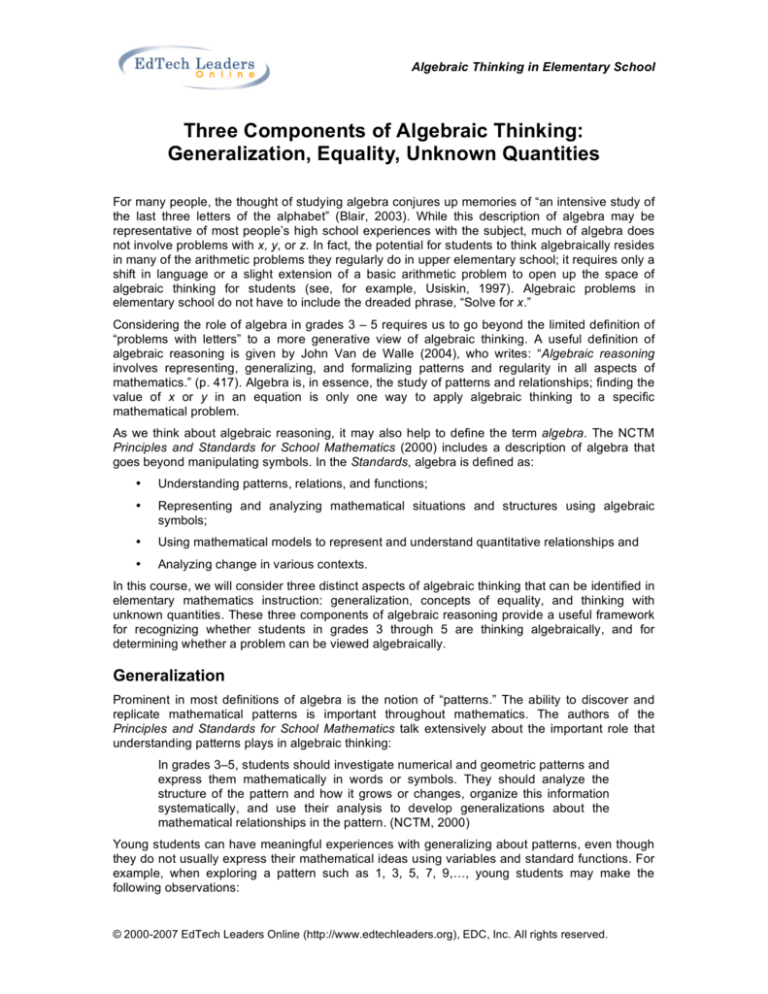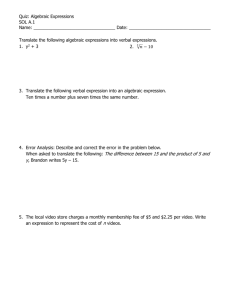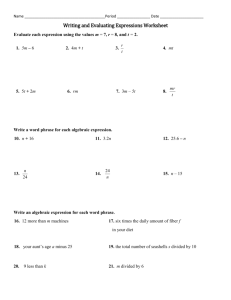
Algebraic Thinking in Elementary School
Three Components of Algebraic Thinking:
Generalization, Equality, Unknown Quantities
For many people, the thought of studying algebra conjures up memories of “an intensive study of
the last three letters of the alphabet” (Blair, 2003). While this description of algebra may be
representative of most people’s high school experiences with the subject, much of algebra does
not involve problems with x, y, or z. In fact, the potential for students to think algebraically resides
in many of the arithmetic problems they regularly do in upper elementary school; it requires only a
shift in language or a slight extension of a basic arithmetic problem to open up the space of
algebraic thinking for students (see, for example, Usiskin, 1997). Algebraic problems in
elementary school do not have to include the dreaded phrase, “Solve for x.”
Considering the role of algebra in grades 3 – 5 requires us to go beyond the limited definition of
“problems with letters” to a more generative view of algebraic thinking. A useful definition of
algebraic reasoning is given by John Van de Walle (2004), who writes: “Algebraic reasoning
involves representing, generalizing, and formalizing patterns and regularity in all aspects of
mathematics.” (p. 417). Algebra is, in essence, the study of patterns and relationships; finding the
value of x or y in an equation is only one way to apply algebraic thinking to a specific
mathematical problem.
As we think about algebraic reasoning, it may also help to define the term algebra. The NCTM
Principles and Standards for School Mathematics (2000) includes a description of algebra that
goes beyond manipulating symbols. In the Standards, algebra is defined as:
•
Understanding patterns, relations, and functions;
•
Representing and analyzing mathematical situations and structures using algebraic
symbols;
•
Using mathematical models to represent and understand quantitative relationships and
•
Analyzing change in various contexts.
In this course, we will consider three distinct aspects of algebraic thinking that can be identified in
elementary mathematics instruction: generalization, concepts of equality, and thinking with
unknown quantities. These three components of algebraic reasoning provide a useful framework
for recognizing whether students in grades 3 through 5 are thinking algebraically, and for
determining whether a problem can be viewed algebraically.
Generalization
Prominent in most definitions of algebra is the notion of “patterns.” The ability to discover and
replicate mathematical patterns is important throughout mathematics. The authors of the
Principles and Standards for School Mathematics talk extensively about the important role that
understanding patterns plays in algebraic thinking:
In grades 3–5, students should investigate numerical and geometric patterns and
express them mathematically in words or symbols. They should analyze the
structure of the pattern and how it grows or changes, organize this information
systematically, and use their analysis to develop generalizations about the
mathematical relationships in the pattern. (NCTM, 2000)
Young students can have meaningful experiences with generalizing about patterns, even though
they do not usually express their mathematical ideas using variables and standard functions. For
example, when exploring a pattern such as 1, 3, 5, 7, 9,…, young students may make the
following observations:
© 2000-2007 EdTech Leaders Online (http://www.edtechleaders.org), EDC, Inc. All rights reserved.
1. “If you add 1 to an even number, you always get an odd number”
2. “If you add 2 to an odd number, you always get another odd number”
3. “If you start at 1 and keep adding 2, you get all the odd numbers”
4. “If you can separate a number into two equal groups, it’s an even number. If one’s left
over, it’s an odd number.”
All of these observations are ways of thinking about a simple pattern—the progression of positive
odd integers. However, they also provide evidence of algebraic reasoning, because each
description relies on some sort of generalization that can be applied to any number. For example,
notice how observation 1 contains the term “an even number.” The student here is generalizing
that no matter how large or small the even number, adding 1 will create an odd number. Likewise,
in observation 4, the student has identified the property that any even number can be split into
even groups, but odd numbers cannot. Both of these observations are examples of
generalization, since they are projecting a mathematical property onto a whole category of
numbers; in this case, “the even numbers.”
It may take some time for students to develop strategies for justifying a pattern. The first steps are
noticing that there is a pattern in a number sequence, and then wondering if that pattern
continues as the numbers get larger. Describing the pattern is the next step, followed by
extending it. Eventually, students will arrive at a generalized understanding of the pattern; they
will be able to predict whether a specific number (or term) is part of a pattern without calculating
each consecutive term. For example, given the pattern 1, 3, 5, 7, 9, …, above, students will be
able to determine that a number such as 381 is part of the pattern because it is an odd number,
and will not need to write out each odd number from 1 to 381 to be convinced of this fact.
In upper elementary school, most students will be ready to work on proving statements such as
“adding 2 to an odd number produces another odd number,” but their ideas about proof will
continue to evolve as they expand upon them in middle school. From a formal algebraic
perspective, all four statements above follow from the fact that all odd numbers are of the form
2n+1, but students can make and test conjectures long before they ever see such an expression.
It is important to keep in mind that as students propose generalizations such as those above, they
may be basing their claims on only one or two instances of a pattern. Mathematically this is not
enough evidence to determine whether a pattern exists. In observation 3 above, for example, a
student may have noticed that adding 1 + 2 = 3 (adding 2 to an odd number produced another
odd number), and adding 3 + 2 = 5, also an odd number. But she may not have investigated any
numbers beyond those. It is important for elementary students to learn that forming
generalizations from only a few instances can lead to inaccurate conclusions.
One example of this can be seen in students’ solutions to the “Frog in the Well” problem in this
session’s video. The students in the video try to use generalization to solve this problem, and
figure that the frog climbs 2 feet total for each 2-hour period because he climbs up three feet in
the first hour and slips down one in the second hour. Using this generalization, they come to the
conclusion that it will take a frog 10 hours to reach the top of a 10-foot well. However, while the
relationship holds in general for each 2-hour period, the ninth hour occurs in the middle of a 2hour period. During this hour the frog reaches the top of the well and climbs out, and
consequently does not “slide down.” While students have made a generalization that is true in
most cases, they have neglected to notice that their current problem is an exception to the
general rule of up three, down two. In the end, their understanding of the relationship actually
misleads them into solving the problem incorrectly.
Equality – the meaning of the “=” sign
Elementary texts sometimes hint at the relationships between arithmetic and algebra by noting
that the problem “add 5 + 24” could just as well be stated “5 + 24 = ?” or “5 + 24 = ❏” or even “5 +
24 = x.” While these notations create a connection between arithmetic and the “missing value”
image of algebra, students can also be misled by the implications of these expressions.
© 2000-2007 EdTech Leaders Online (http://www.edtechleaders.org), EDC, Inc. All rights reserved.
For example, consider the algebraic statement “5 + 24 = ? + 15.” On the face of it, this expression
is similar to the previous ones (e.g. 5 + 24 = ?) but there is one very important difference: the
number that replaces the ? is no longer 29, but a smaller number that when added to 15,
produces 29. However, when faced with a problem like this, research has shown that many
elementary students persist in saying the answer is either the sum of the two addends to the left
of the equals sign, or the sum of all the addends in the problem, regardless of their placement
relative to the equals sign (Falkner, Levi, & Carpenter, 1999). Consequently, given the problem “5
+ 24 = ? + 15,” most elementary students would respond that the missing number was either 29
or 44..
What’s going on here? The issue resides in the meaning students assign to the “=” sign. In the
case of the problem “5 + 24 = ?” the “=” can be thought of as “the result of the previous
computation.” That is a sufficient interpretation in this problem. However, in the example “5 + 24 =
? + 15,” the equals sign must be interpreted differently. It is now a statement of equivalence
between two quantities, in this case between “5 + 24” and “? + 5.” Now it is clearer that the ?
must be replaced by something other than 29, since “5 + 24” and “29 + 15” are not equivalent.
Understanding that the sign “=” requires that one side of the expression be equivalent to the other
is a basic tenet of algebra. Students will be stretching their algebraic reasoning skills if they see a
variety of problems with unknowns in different positions, such as:
•
4 + ? = 17 + 2
•
? + 15 = 12 + 32
•
13 + 24 = 50 + ? (Note that this problem has a negative integer as a value for ?, which
may or may not be appropriate for your students.)
Thinking about unknown quantities
Besides the word “variable,” “unknown” is one of the words most frequently associated with
algebra. Along with this concept comes the idea that the “unknown” will eventually become
“known;” this is what solving equations is usually about. But it’s possible (and important) for
students to work with expressions that include a variable that remains unknown. Most number
tricks of the form, “choose a number, multiply it by 3, add 6, divide by 3, subtract 2 and tell me the
number – and I’ll tell you your original number,” can be expressed algebraically without the need
to use an specific number. The algebraic component is that the trick works for all numbers, not
just a specific one for which we have to solve.
Here’s an example of a problem with an unknown quantity that remains unknown. This problem is
appropriate for students in grades 3 through 5:
Suppose Keisha has some number of pieces of candy in her bowl. Aman has 3
more pieces of candy than Keisha has. Keisha’s mother gives her 5 more pieces
of candy. Now who has more? How many more? Then Keisha gives Aman one
of her pieces of candy. Now who has more? How many more?
Students can solve this problem without creating algebraic expressions that contain variables.
They may draw a picture to represent the number of candies Keisha has (e.g. a circle), and then
represent Aman’s candies with a circle and three extra X’s. They could then manipulate the
pictures without ever specifying what is in the circle.
In this problem, finding the exact amount of candies Keisha has is not important, since the
problem asks for a comparison between two quantities.
© 2000-2007 EdTech Leaders Online (http://www.edtechleaders.org), EDC, Inc. All rights reserved.
Keisha
Keisha
Aman
Aman
In this diagram, the amount of candy that
Keisha and Aman begin with is represented
as ovals. The extra pieces the Aman has are
represented as x’s. This diagram shows that
Aman has more candy, since he has 3 x’s,
and Keisha has none.
In this diagram, Keisha has been given 5
more pieces of candy, which are represented
by x’s. Since she has more x’s (or individual
pieces of candy) than Aman, she must also
have more total candy, because the
quantities in the ovals are the same.
However, some problems similar to the one above cannot be solved without figuring out the value
of an unknown number of candies. For example:
Suppose Keisha has some number of pieces of candy in her bowl. Aman has 3
more pieces of candy than Keisha has. If Keisha gets more candies so that she
has twice as many as before, who has more candies now? How many more?
There isn’t a single answer to this problem; it depends on how many candies Keisha had to begin
with. So, if Keisha had 2 candies originally, Keisha will now have 4, and Aman will have 5. On the
other hand, if Keisha begins with 5 candies, then she will now have 10, while Aman has 8. The
difference between these two kinds of problems is subtle, but as students approach fifth grade,
they should be able to start making the distinction and solving them appropriately.
These types of problems help develop algebraic reasoning skills because they require students to
think flexibly about quantities, and to learn how to compare related quantities. They also promote
the idea that the relationship between two quantities (here, whether Keisha or Aman has more
candies) can change depending on how the original amount is acted upon.
Getting ready for formal algebra
If students have experiences with all three kinds of algebraic thinking tasks in elementary school,
they will come to the “formal” study of algebra in middle and high school armed with an alreadydeveloped ability to reason algebraically. For example, as they encounter more complex linear
equations in middle school, students will be able to interpret the “=” sign as an indication of
equality, not as a sign requiring them to compute something. They will have already considered
the kinds of patterns that they may now be asked to express in algebraic form. And they will be
prepared to work flexibly with variables as unknown quantities rather than needing to figure out its
value immediately. With these insights in hand, students will find that algebra is not a mystery, but
a territory that already has familiar landmarks.
References
Blair, L. (2003). It's Elementary: Introducing Algebraic Thinking Before High School. SEDL Letter,
15(1), 16-20.
Falkner, K., Levi, L., & Carpenter, T. (1999). Children's Understanding of Equality: A Foundation
for Algebra. Teaching Children Mathematics, 6(4), 232-236.
National Council of Teachers of Mathematics (2000). Principles and standards for school
mathematics. Reston, VA: NCTM.
Usiskin, Z. (1997). Doing Algebra in Grades K-4. Teaching Children Mathematics, 3(6), 346-356.
Van de Walle, J. A. (2004). Elementary and middle school mathematics: teaching
th
developmentally (5 ed.). New York: Longman.
© 2000-2007 EdTech Leaders Online (http://www.edtechleaders.org), EDC, Inc. All rights reserved.






